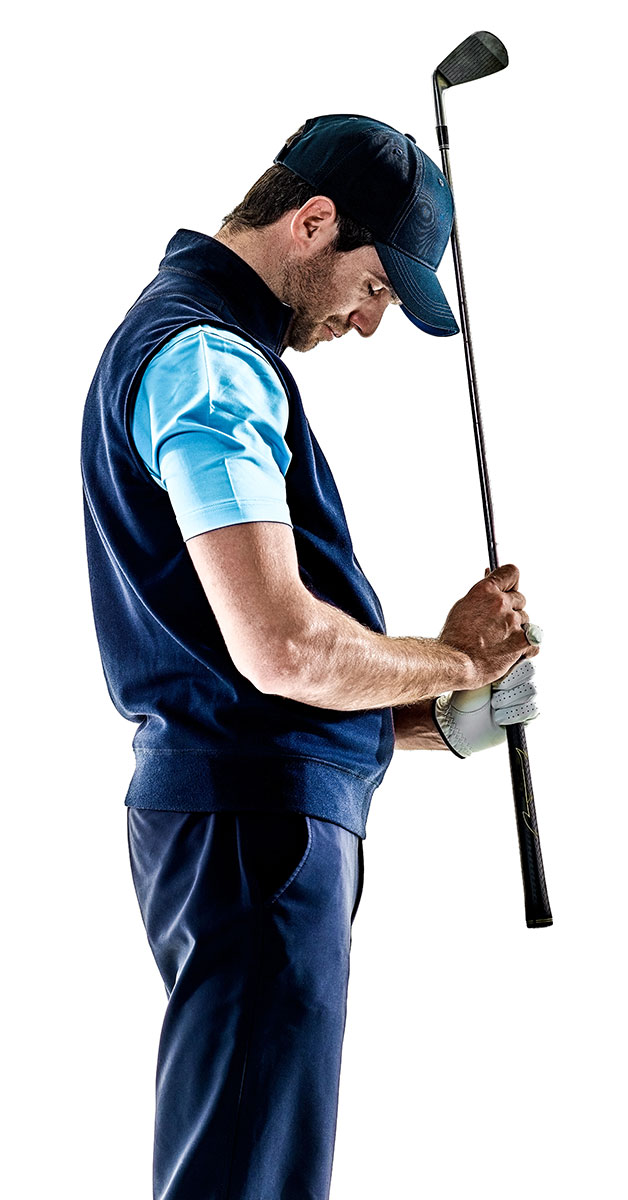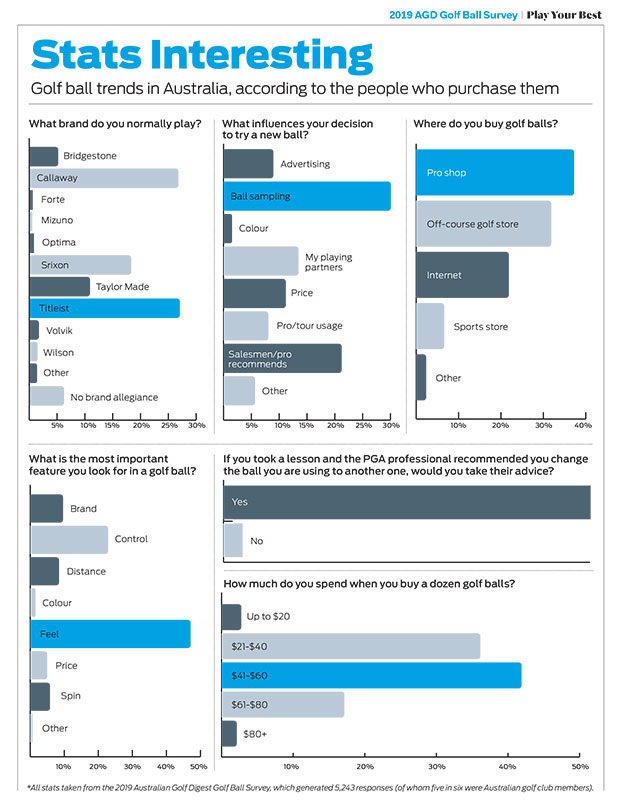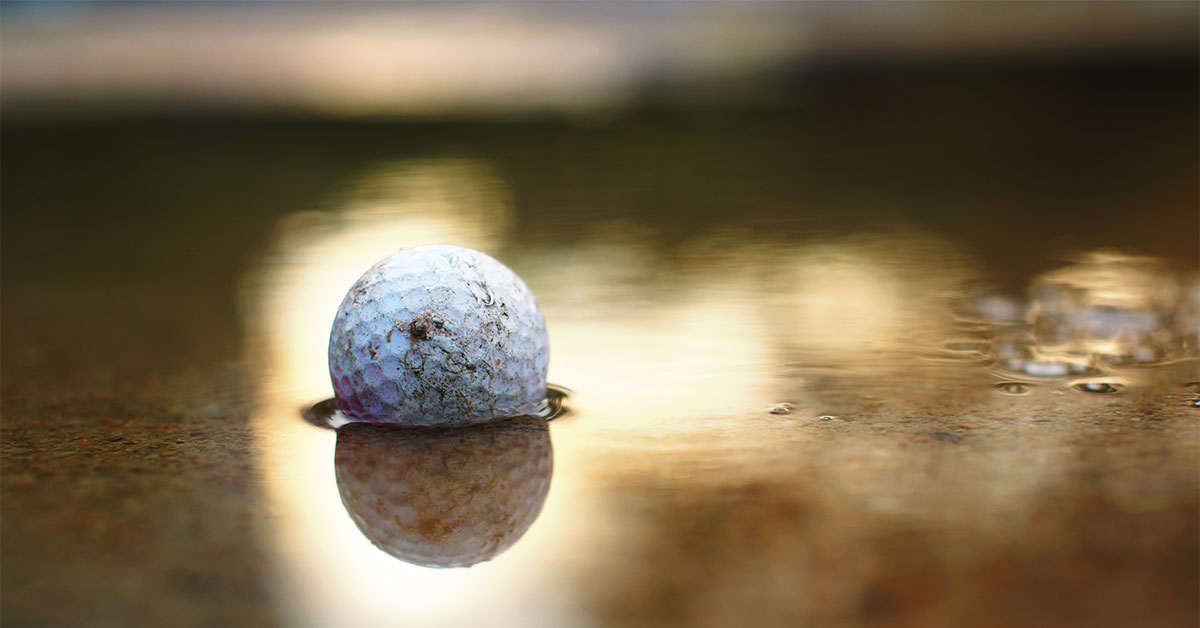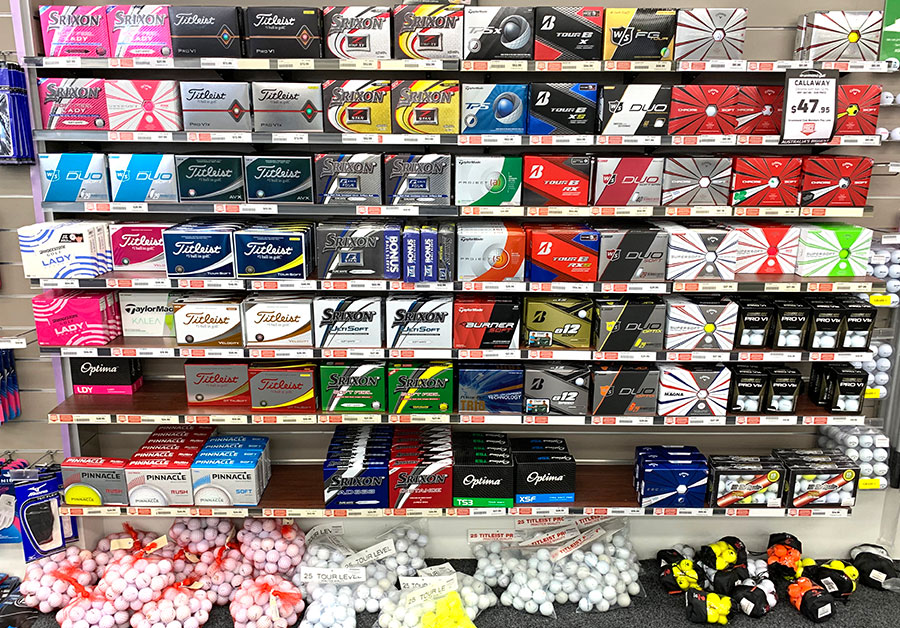Citius, Altius, Fortius. Or as we’ve come to know ‘Faster, Higher, Stronger’ has been the motto – the embodiment – of the International Olympic Committee since its origins in 1894.
When it comes to the golf ball, such is the importance of marketing that it would come as no surprise if a manufacturer attempted to trademark the Latin translation of ‘Faster, Longer, Straighter’. Because propaganda is at the heart of golf’s ‘Ball Wars’ and the struggle for market share.
After all, golf-ball manufacturing is big business. Very big. The global ball market has been valued at $US1.1 billion annually. And judging by the claims (and counter-claims) by ball manufacturers, the competition appears to be more intense than ever.

What The Manufacturers Say Is Their Point Of Difference
Walk into any Drummond Golf, Golf Box or your local on-course golf shop and the choice is bamboozling. The quality and variety of balls on the shelves is simply outstanding. Hence, marketing/advertising is paramount. And each ball manufacturer has a great tale to tell.
Callaway says its Chrome Soft has certainly had an impact on the way all balls, specifically tour balls, are manufactured. That is with a softer, low-compression tour ball. According to Callaway, the Chrome Soft will be the best combination of distance and greenside control for all golfers.
Volvik’s S3 and S4 tour balls have a slightly different construction model to most other tour balls. While most tour balls have a soft core, Volvik’s S3 and S4 have a firm core covered with soft outer layers to help transfer power and maximise distance.
Bridgestone Golf says its biggest point of difference is a collection of ball-fitting data from more than 300,000 golfers that’s been compiled in the past 12 years, enabling Bridgestone to produce balls that fit each player profile.
And with its Pro V1 and Pro V1x, Titleist prides itself on having the most played ball in professional golf. The Pro V1 has evolved since its launch in October 2000 and Titleist says the new Pro V1 and Pro V1x have been designed to leave the clubface with more ball speed and lower long game spin for more distance while still providing the best short game control.
 Innovation and Various Types Of Ball On The Market
Innovation and Various Types Of Ball On The Market
With all of these bold, emphatic statements, how is the consumer meant to differentiate between all of the balls on the market?
The good news is that research and development over many decades has led to the evolution of the modern ball that can cater to a wide range of ability levels. The most important thing that continues to evolve, says Callaway, is how balls can achieve longer distance while still maintaining spin and performance around the greens.
Soft-core technology has been the biggest innovation over the past two decades, according to Bridgestone. Tour players are able to optimise spin rate for their shots. Less-accomplished golfers get benefit from reduced side/back spin, which allows them to hit the ball straighter and longer.
Hence, the challenge is to find the ball that suits you best. Because if there was just one ball for everyone, then why does each manufacturer make different balls?
Observations/Trends At Retail And Consumer Habits
To get a feel for the fickle nature of the ball market, look no further than Moore Park Golf near Sydney’s CBD. The harbour city’s busiest course has witnessed a remarkable change in purchasing habits, judging by data collected by Moore Park operations manager and PGA member Neville Austin.
On the back of a 257 percent increase in sales, Callaway’s Chrome Soft has overtaken Titleist’s Pro V1 as the top-selling premium ball, says Austin, although combined sales of the Pro V1 and Pro V1x are better. Srixon Soft Feel is the second-best selling ball, while Volvik Single Crystal is third, followed by the Pro V1, Pro V1x and Titleist’s DT Truesoft. Another Titleist ball, the AVX, has gained good traction since entering the market and Titleist is easily the No.1 brand at Moore Park.
Across the city at Bankstown Golf Club and it’s a different story altogether. TaylorMade TP5 is the top-selling ball model while Srixon is the No.1 brand at the private club in Sydney’s western suburbs. Bankstown head professional Lee Hunt says “position in store” is the most important factor that drives ball sales. Most customers always look for value rather than price.
“Titleist Pro V1 is no longer the only premium ball on the market. Callaway, Srixon, Bridgestone and TaylorMade have really got their act together,” says Hunt, who adds that the internet has had little effect on his business.
“Titleist Pro V1 is no longer the only premium ball on the market. Callaway, Srixon, Bridgestone and TaylorMade have really got their act together,” – Lee Hunt, Bankstown Golf Club
As for whether there is a correlation in sales between the ball that star players use and the ball his customers buy, Hunt says, “Tiger Woods has really been the only person to move the needle in that space. Bridgestone sales did not register until Tiger started playing the ball [Tour B XS] and played well.”
In Western Australia, Srixon Distance is the most popular ball model sold at Carramar Golf Course. Professional Tim Crosbie says Callaway is the No.1 selling ball brand at the public course in Perth’s northern suburbs. Price is a huge factor in ball selection at a public course says Crosbie and “specials” on a dozen balls see them “walk out the door”.
Yarra Yarra Golf Club head professional Andrew Bertram is in a unique position to gauge consumer habits as the pro at one of the more fashionable private clubs in Melbourne. Interestingly, Bertram says just 5 percent of his customers are driven by price when purchasing golf balls.
From a retail perspective, 90 percent of balls at Yarra Yarra are purchased by the dozen, 10 percent in sleeves and very few in singles. The internet has changed ball sales marginally (21.86 percent of golfers in Australia purchase golf balls online, according to Australian Golf Digest’s 2019 Golf Ball Survey – see below).

TaylorMade TP5/TP5x is the top-selling ball model over the counter at Yarra Yarra. Premium balls – TaylorMade’s TP5, Titleist’s Pro V1 and Callaway’s Chrome Soft – account for 75 percent of ball sales. However, Titleist is the top-selling ball brand. (The Titleist Tour Soft and Titleist Velocity sell OK, but the mid-range TaylorMade ball doesn’t sell at all.)
Even though three in four ball sales are premium, Bertram says there is no correlation between the ball that top players use and what customers purchase at Yarra Yarra. Citing Tiger Woods as an example, he says his staff never gets asked for Bridgestone. (Hence, this is a completely different purchasing habit by comparison with the public-access Carramar Golf Course in WA.)

No Shame In Playing A Coloured Ball
The stigma of playing a coloured golf ball appears to be waning. Senior golfers with worsening eyesight are far more likely to buy coloured balls now than two years ago, says Bertram. Not just coloured balls, but balls that are easier to see like Callaway’s Chrome Soft hi vis and the new TaylorMade TP5 hi vis (24.17 percent of Aussie golfers use coloured balls, according to our survey).
No doubt Bubba Watson’s flirtation with a pink golf ball helped to change people’s perceptions. The two-time Masters champ put Volvik’s S4 ball in play during 2017 after watching participants in the World Long Drive Championship.
Volvik’s Jason Bridge says the whole ball manufacturing industry has embraced non-white balls: “Six years ago Volvik pioneered matte finish balls. Now most of the other companies have followed our lead and produce matte finish balls. It’s great for the category as it gives some real legitimacy to coloured balls.”
Time To Get Ball Fitted
Club-fitting is a well-established practice when it comes to choosing a new set of sticks. However, the concept of ‘ball fitting’ is something all golfers must consider if they want to play better golf. Golfers are doing themselves a disservice by randomly selecting a ball based on gut feeling.
Consumers should absolutely consider a ball fitting, says Callaway’s Matt Meredith. “The right ball is very important to the performance of your game. How much you could gain or lose is totally dependent on the player and what their current launch conditions are. It is not uncommon for a player to pick up five to 10 metres based on a change in ball. As you move up the price ladder as well, golfers can also see a big difference in greenside spin and control.”
‘It is not uncommon for a player to pick up five to 10 metres based on a change in ball.’ – Matt Meredith, Callaway
Volvik’s Jason Bridge says using the wrong type of ball can greatly affect your ball flight, which will affect distance and your ability to control the ball: “I’ve seen people losing 20-plus metres by hitting the wrong ball. It seems like common sense but the ball the PGA Tour star is using on TV is highly unlikely to be the right ball for the 18-handicap golfer who plays once a week. Although lots of marketing campaigns will tell you they do.”
‘The ball the PGA Tour star is using on TV is highly unlikely to be the right ball for the 18-handicap golfer who plays once a week.’ – Jason Bridge, Volvik
The common misconception by amateur golfers is that they need to play with the ball used by the professionals. “[The assumption is] they all need to play the Pro V1, which they don’t,” says teaching professional Jason Laws. “If you’ve got a slower swing, get a ball that actually suits you.”
Unaccomplished golfers shouldn’t use a ‘premium ball’ used by the pros on tour simply because they don’t generate enough clubhead/ball speed and can’t control the spin of that golf ball. It won’t give them an advantage because their clubhead/ball speed isn’t enough to create the velocity in that ball each time to get the consistency of distance, flight and spin rate.
Take, for example, a male 7-handicapper at the age of 70. A good handicap with a slower swing speed. Laws says he would benefit by using a Callaway Chrome Soft golf ball for more distance, enabling a high launch angle with a little bit of spin. He would gain some more distance and be in closer proximity to the green on approach shots than he would be with a Titleist Pro V1.
Consideration should be made with regard to what sort of grass you normally play off. Is it tight, is it thicker, or somewhere in between? And do you need to combine the golf ball with the bounce on your sand iron?
The type of course you frequently play also makes a difference. Laws uses the scenario of playing at a couple of well-known Sydney courses. If an “average golfer” were to play at New South Wales Golf Club on Sydney’s east coast, Laws would suggest they use Titleist’s AVX because it has a lower launch angle, lower spin rate and is perfect for a windy course. Yet just 10 kilometres away at The Australian Golf Club, Laws believes that same average golfer would benefit by playing Callaway’s ERC ball, which flies higher and further and is therefore a better option for hitting shots into elevated greens.
“Some of the mid-range balls are as good as the other ones,” Laws says. “Out of all the golf balls on the market, the average person should look at the ERC Callaway golf ball. That is a brilliant golf ball. It’s the longest ball they’ve ever made. Phil Mickelson uses the thing so it’s got to be good. And it goes further, it goes higher and it’s got less spin. That’s just perfect for the guy that wants to hit the ball a lot further. They’re the sorts of golf balls they’ve got to look at.”

How To Choose A Ball
According to Laws, the biggest mistake most golfers make when selecting a ball is they don’t consider three factors: the distance they require, the type of flight (high or low trajectory) they want and what sort of spin they need around the greens. With regard to lost strokes, he estimates playing the wrong type of ball can be costly – a minimum of three shots a round for a 20-handicapper.
The first choice when selecting a ball should be to determine whether the priority is distance off the tee or feel around the greens. Then narrow it down to the balls for testing to make sure you cover both ends of the spectrum – distance and feel.
Take the time to locate an on-course golf shop or off-course retailer with a launch monitor. Test hitting different balls under the supervision of an experienced clubfitter. Ask the clubfitter to show you on the ball monitor exactly which ball suits you best.
Finally, pick five different types/brands of ball and go and hit chip shots. Because touch around the greens is the biggest thing a golfer has to consider other than off the tee with the driver.
And always practise with the same ball you intend to play with on the golf course “so that you have the feel of what that golf ball does for you – [how it spins or how it rolls]”, says Laws. “Everyone is so different.”
 What our readers say
What our readers say
With so much choice in the marketplace, Australian Golf Digest conducted its most comprehensive reader survey on golf ball habits. With 5,243 respondents (of whom five in six were club members), it represented a substantial poll of Australian golfers. The survey delivered some interesting data:
• Callaway and Titleist are pretty even as to the most popular brand of ball in Australia with Srixon third and TaylorMade fourth.
• Feel is more important than distance – 47 percent of respondents prioritise feel while just 8.5 percent choose a ball based on distance.
• Coloured balls are on the rise – almost one in four golfers (24 percent) play a non-white ball.
• Price is still an important consideration when buying balls – only 19 percent of respondents said they would spend more than $60 on a box of balls.
• Golfers still prefer to purchase balls in a ‘pro shop’ (37 percent) despite the surge in shopping across the internet (22 percent).
• More than a third of golfers have no idea about the cover of their current ball – 37 percent didn’t know if they were playing a premium multi-layer ball with a urethane cover or a two-piece surlyn ball.
• Almost three in four golfers (74 percent) recommend a ball to their mates.
• Sampling is the biggest influence on changing from one ball to another.
• Playing three rounds or less with another ball is all it takes to switch balls for 70 percent of golfers.
• Ball fitting is a relatively foreign concept – just one in six of those golfers surveyed (17.6 percent) had been ‘ball fitted’ using some form of launch monitor.
• 95 percent of respondents said they would change balls if their pro recommended a better ball for them.
So what does that tell us? Well, for all the promises of greater distance made by manufacturers, almost half of respondents prioritise feel when selecting a ball. And, in what should be a startling revelation for distributors and retailers, most golfers will tend to switch their brand of ball all of a sudden:
a) by having sampled another type of ball for less than a handful of rounds,
b) by listening to a friend’s glowing endorsement, or
c) from their pro’s recommendation.
However, as Australia’s No.1 golf publication, our major concern is that an overwhelming majority of golfers are failing to reach their full potential by not getting ‘ball fitted’. How could they possibly know if the ball they’re playing is best for them if they haven’t had their swing analysed on a launch monitor?



